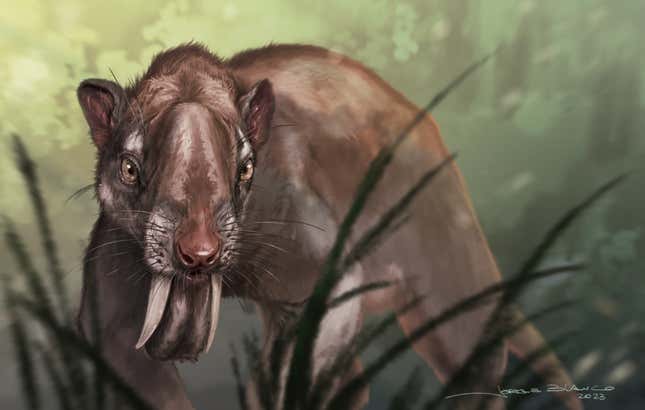
With two massive canines, an L-shaped jaw, and a pouch to carry its young, the saber-toothed marsupial Thylacosmilus atrox sounds like an evolutionary Madlib. But researchers have now described an extra quirk: surprisingly wide-set eyes, more typical of horses and cows than carnivorous animals.
The finding makes the predator an even more intriguing specimen, raising questions about how evolution engineers predators and why the South American marsupial evolved such an uncommon ocular layout. The team’s findings are published today in Communications Biology.
“Compensation appears to be the key to understanding how the skull of Thylacosmilus was put together,” said Ross MacPhee, a senior curator at the American Museum of Natural History and co-author of the paper, in a museum release. “In effect, the growth pattern of the canines during early cranial development would have displaced the orbits away from the front of the face, producing the result we see in adult skulls.”
Thylacosmilus was larger than any extant marsupial carnivore today, weighing more than three times as much as the thylacine, the largest carnivorous marsupial until its extinction in the 1930s.
Modern carnivores (including the thylacine, until its demise) typically have eyes toward the front of their face, giving them stereoscopic vision that helps them determine the exact position of their prey. With eyes on the sides of your head, you have less overlap in what your eyes can see.
But as evidenced in the new research, Thylacosmilus’ morphology corrected for its eye sockets’ position by having them stick out from the skull and orienting them vertically. This positioning improved the predator’s orbital overlap.

The scientists estimated Thylacosmilus’ orbital convergence to be as low as 35 degrees (for comparison, a domestic cat has a convergence of about 65 degrees). But the marsupial’s visual field still managed about a 70% overlap, giving the creature a reasonable amount of 3D vision despite its cow-like eye socket position.
The roots of the marsupial sabertooth’s huge canines extended over the top of its skull. As a result, there was no room toward the front of the animal’s head for eyes.
But why did Thylacosmilus bother to develop such a remarkable pair of canines? If they were like those of saber-tooth cats, they could have been used to puncture foes. But Thylacosmilus was an ambush predator, and the exact utility of its dagger-like canines is elusive.
“To look for clear-cut adaptive explanations in evolutionary biology is fun but largely futile,” said Analia Forasiepe, a researcher at the Instituto Argentino de Nivología, Glaciología, y Ciencias Ambientales and CONICET, in the museum release. “One thing is clear: Thylacosmilus was not a freak of nature, but in its time and place it managed, apparently quite admirably, to survive as an ambush predator.”
“We may view it as an anomaly because it doesn’t fit within our preconceived categories of what a proper mammalian carnivore should look like, but evolution makes its own rules,” Forasiepe added.
Thylacosmilus likely died out around 3 million years ago. Other large marsupial predators have gone extinct much more recently. Thylacoleo—the marsupial lion native to Australia—was the largest of the bunch and is thought to have disappeared around 35,000 years ago. Around the same time, a tree-climbing kangaroo five times larger than its modern brethren also went extinct on the continent.
More: Ancient Carnivorous Dread-Possum Is Upending the History of Mammals